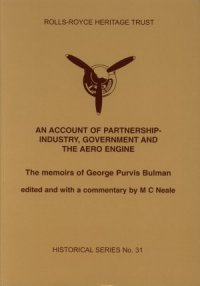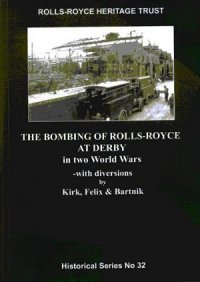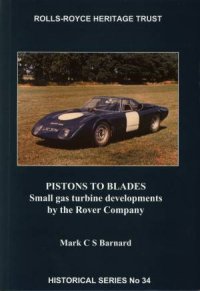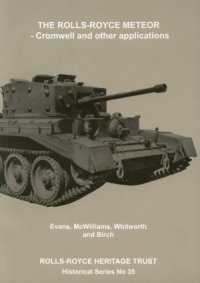Rolls-Royce Heritage Trust
Historical Series Reviews - Page 04
 |
An Account of Partnership
- Industry, Government and the Aero Engine
The Memoirs of George Purvis Bulman
Edited and with a commentary by M C Neale
Rolls-Royce Heritage Trust
P.O. Box 31
Derby DE24 8BJ
England
Recommended Retail Price:
Please see Book List/Order Form
|
Reviewed by Graham White
Another book from the
Rolls-Royce Heritage Trust Historical Series, this is one well worth buying and
as always at a bargain basement price.
Major George Bulman played
a crucial role in Britain's embryonic aircraft engine development business. As a government
employee, Bulman's responsibilities included the determination of whether an
aircraft power plant was fit for Royal Air Force service. His official title was
Director of Engine Development and Production. Just from this brief title, it
can be seen that Bulman's responsibilities ranged far and wide.
This autobiography was
written in the late 1960s but for various reasons was never published. It is
thanks to M C Neale, one of Bulman's successors, that this manuscript saw the
light of day. And what a wonderful account it turned out to be.
To prepare the reader for
what is in store, Neale wrote a lengthy and informative introduction. Although
Neal's writing style could be irritating due to "chopped-up" sentences and at
times, an awkward grammar style, it is highly recommended and well worth the
effort to read his intro.
At the onset of World War
I, not surprisingly, the British had no organized aircraft engine capability,
therefore this responsibility was thrust upon the government. It is during this
embryonic stage that Bulman enters the picture and remains in engine development
and production until his departure in 1942. During his tenure, Bulman rubbed
shoulders with all the movers and shakers of British aviation including his
close friend Frank Halford plus Ernest Hives, Rod Banks, Wilfrid Freeman,
Winston Churchill, Dr. Roxbee Cox, Harry Ricardo, Roy Fedden and many other
luminaries. His involvement with the Schneider Trophy races shed more light on
this fascinating contest of national pride and honor. The story of the infamous
head and bank change on the Rolls-Royce R the night before the 1929 race
has been well documented. But the manner in which the head and bank assembly was
changed has never been dealt with. Even Bulman's text does not get into any
details but a painting depicting the change occupies a full page of the book.
Normally, when a bank is removed from a 60 degree V-12, the engine is rotated 30
degrees in order to remove the bank vertically. With the engine mounted in the
aircraft, this 30 degree tilt becomes problematic. However, in a scene similar
to, "if Mohammed will not go to the mountain then move the mountain to
Mohammed," the Rolls-Royce mechanics charged with replacing the problematic bank
assembly tilted the entire Supermarine S6B the requisite 30 degrees. Fascinating
stuff..!!!
As war clouds gathered in
the mid to late 1930s, it was thanks to Bulman's proactive approach to engine
manufacturing that the British were somewhat prepared; or at least as prepared
as one can be with such a calamitous event about to overtake the entire world.
Thank goodness Bulman got the British car industry geared up for production of
aircraft engines. And remember, as today, the top executives of the 1930s were
an egocentric bunch to whom the term "team player" as it pertained to
cooperating with their bitterest rivals was anathema. Nevertheless, Bulman
managed to get them to pull together for the national good.
After reading Bulman's
account, it was obvious the war took a terrible toll on him, even though he
didn't always admit to such in the text. At times, a reader needs to read
between the lines to understand the implied messages. One cannot help but admire
his charity towards those who would stab him in the back or otherwise do him
political harm. Having a top level government job clearly thrust him into the
inevitable politics that came as part and parcel with the position. With one
exception, he had nothing but praise for those he worked with and worked for.
The one exception was Frank Whittle. Perhaps we will never get the whole truth
on this sordid episode. But fact of the matter is, Whittle received a patent for
the jet engine in 1930 handing the British a 10 year lead in gas turbine
development. By the early 1940s the British were lagging behind the Germans due
to ineptitude and a lack of appreciation of what this new technology was capable
of. This tremendous lead was frittered away. Bulman has to take at least some
responsibility for this sorry state of affairs, instead he blames Whittle and
his difficult personality. All accounts seem to support the contention that
Whittle was difficult to work with, nevertheless, when a world beating
technology comes along it is incumbent upon those in power to exploit this new
technology to the full regardless of the difficulties in dealing with "unique"
personalities. The British missed the boat on this one—big time.
Bulman's downfall appears
to have been the result of protracted problems with the Napier Sabre. In
all fairness, he was given a classic "Mission Impossible" with this complex and
problematic engine. Exacerbating Bulman's situation was the apparent
lackadaisical attitude Napier executives demonstrated. No wonder the US turned down manufacturing rights to this complex nightmare. Perhaps
Bulman's close association with Halford, the Sabre's creator, had a lot
to do with his fall from grace. According to Bulman's account, the Sabre
was finally coming out of the woods and turning into a useful engine for RAF
Typhoons when he was unceremoniously posted to a different position. Rod
Banks replaced Bulman and received all the accolades for "fixing" the Sabre
problems. I find it interesting to read Bulman's account and compare it with
Banks' account — it's almost as if we are reading about two different stories.
Likewise, comparing Whittle's biography shows a different spin on how events
transpired. I don't have a copy yet but it will be interesting to see how
Freeman's biography holds up in comparison.
It was somewhat surprising
to see a number of errors in the book that could have easily been corrected in
the editing stage. The photo of a Hispano Suiza V-8 shown upside down was a real
blooper. An even more egregious error was the photo of government and industry
big shots supposedly looking at a Napier Sabre. The photo actually shown
was a Napier Dagger, a very different engine. Bulman leaves the reader
with the impression that the Rolls-Royce Eagle 22 was an exact copy of
the Napier Sabre. In fact the Eagle 22, although conceptually the
same as the Sabre, was a totally different engine. Development of the
two-stage Merlin is covered. These were 60 series Merlins but the
text incorrectly describes the first two-stage Merlin as the Merlin XX.
In fact, this latter engine was single stage engine.
Overall, this book
represents a great read with all the intrigue and politicking that one could
ever envision.
 |
The Bombing of Rolls-Royce at Derby
in two World Wars - with diversions
by Kirk, Felix & Bartnik
Rolls-Royce Heritage Trust
P.O. Box 31
Derby DE24 8BJ
England
Recommended Retail Price:
Please see Book List/Order Form
|
Reviewed by Graham White
With yet another addition
to the Rolls-Royce Heritage Trust Historical Series, it is now becoming a
veritable collection. This book represents No 32.
Although not directly
aircraft engine related, as its sub title; - with diversions, implies,
the story manages to wrap enough aircraft material into the text to make it
worthwhile reading. The concept of the book is to use various bombing raids on
the Rolls-Royce manufacturing facility in Derby, England to describe the
offensive and defensive equipment used. In this way, the reader can get a better
understanding of the Zeppelins used to bombard England during World War I. Using the bombing of the
Derby area as a backdrop, the authors went into
great detail into the history the Zeppelin, its development, the Maybach engines
that powered them, etc. Of course, the British would not and could not take this
assault on their homeland unopposed so the book delves into the British fighters
of the day. It could be argued the authors were diverging off the subject and
this was either implied or; admitted to in the text.
Most of the book was
devoted to a bombing raid by a Dornier Do217 twin engined medium bomber that
dropped its bombs on the Rolls-Royce Derby factory in 1942. Nice anecdotes are
offered into the strategy of barrage balloons and how effective or otherwise
they were. Nice description of the BMW 801 radial engine that powered the Do217
is offered. However, this reviewer would like to make some comments regarding
this engine. Although this myth has been perpetuated many times, the 801 was not
based on a Pratt & Whitney design even though BMW built P&W R-1690s under
license. The authors do a comparison of the 801 with some of its contemporaries
such as the Merlin, Wright R-1820, Hercules, etc. But the one engine that bore
the most resemblance to the 801 was omitted. That engine was the Wright R-2600.
I make mention of this because in this reviewer's opinion, the 801 was copied
from the R-2600. Several facts support this; (i) they are the same
configuration, i.e, 14 cylinder, two row air-cooled radials, (ii) they are of
almost identical displacement, (iii) their conceptual design is identical, i.e,
three piece crank, one piece master rods running in plan bearings and the crank
is supported in rolling element bearings, but most telling of all is (iv) their
crankcase design. Wright developed an unusual way to make their radial engine
crankcases in the late 1930s; that of using forged steel. The 801 also used this
unusual manufacturing method. Lastly, Wright's top design engineer was German
who still maintained contact with his German friends. Would it be a stretch to
assume that he let the cat out of the bag regarding the forged steel crankcase?
Incidentally, the forged steel process was not as heavy as one would think.
Wright crankcases and presumably the BMW 801, used extraordinarily thin sections
where the stresses were low. So overall, it weighed no more than a forged
aluminum crankcase. Excellent insight is offered into the defensive measures
taken by the Germans to protect their aircraft against cables from barrage
balloons. Hard to imagine, but the Do217 that attacked Derby actually ran into a
cable and lived to tell about it.
A couple of relatively
minor errors crept in.
On page 45 it appears the
authors got their years mixed up and 1938 is described as 1939.
The Do217 landing gear was
described as "Its electrically operated 'undercarriage' was effective and
reliable, though it could have been more robust — on take at full load it had a
most unpleasant 'shimmy'." This implies that the main gear shimmied; in
fact, it was in all likelihood the tail wheel that shimmied — a very common
prob— and not just with German aircraft.
It's a very specialized
book that may not appeal to most of us on this side of the pond but like all
their other books, this one represents an absolute bargain. This reviewer buys
every R-RHT Historical Series as soon as it becomes available. You'd pay more
for some magazines than you would for this book.
 |
Pistons to Blades
Small gas turbine developments
by the Rover Company
by Mark CS Barnard
ISBN 1 872922 23 6
Rolls-Royce Heritage Trust
P.O. Box 31
Derby DE24 8BJ
England
Recommended Retail Price:
Please see Book List/Order Form
|
Reviewed by Graham White
The Rover car company got a head start in the development
of gas turbines when Frank Whittle was in the early development stages of his
revolutionary engine. In 1943 the Wilks brothers of Rover met with Hives of
Rolls-Royce to swap gas turbine development for all manufacturing rights to the
Meteor tank engine. At this point it would appear that Rover was now out of the
gas turbine field. Not so. Immediately after World War II Rover embarked upon
small gas turbine development for automotive use, probably the first in the
world to do so. By 1950 Rover had developed a 150hp turbine that was used to
power a pedestrian P4 sedan highly modified into a two a seater. Pioneering new
ground, all the problems that are now well known such as; cost, poor throttle
response, poor fuel economy and developing heat exchangers, were just some of
the hurdles to be overcome. This excellent book offers fascinating insight as to
how these problems were first discovered and secondly overcome. Although it
could be argued that some of these issues were never satisfactorily fixed — by
Rover or any one else. Despite spending several decades dinking around with gas
turbines, the market place was not ready. One gets the impression from reading
the book that Rover came agonizingly close to making a marketing success of
their small turbine engines but then found themselves falling short due to a
number of factors including cost, fuel consumption or reliability. Every
imaginable application was tried including cars, race cars, boats, trucks, fire
pumps, trains, small aircraft and APUs for Vulcan bombers. Some of the foregoing
offered a modicum of commercial success but the majority ended up being
prototypes. I found it fascinating to read that the fire pump application was
hand cranked, surely a first for a gas turbine..!!!
A small section is devoted to other companies that delved
into automotive gas turbines such as Chrysler and Fiat.
Numerous photographs and cutaway line drawings are used to
illustrate the book. This book is number 34 in the Rolls-Royce Heritage Trust
series and therefore represents fabulous value for money. It's a great read and
well worth purchasing.
 |
The Rolls-Royce Meteor
Cromwell and Other Applications
by Evans, McWilliams, Whitworth and Birch
Softbound, 204 pages
Rolls-Royce Heritage Trust
P.O. Box 31
Derby DE24 8BJ
England
Recommended Retail Price:
Please see Book List/Order Form
|
Reviewed by Graham White
Number 35 in the
Rolls-Royce Heritage Trust Series is yet another jewel of a book. These books
still amaze for their value; for the price of an average magazine you get an
authoritatively written tome. Most people are aware of the Merlin being
converted for use as a tank power plant and the famous swap whereby Rolls-Royce
gave Rover the tank engine business in exchange for Rolls-Royce acquiring
Rover's gas turbine business. This is the first detailed history of the Merlin
conversion from the desperate days of WWII through the early 1960s when
production of the Meteor ceased. The book delves into all the Meteor powered
tanks and tank design including suspensions and transmissions. The little known
Meteorite, a V-8 version of the Meteor is also covered. For the hard core gear
head or tank history enthusiast this book is a must buy.
 |
50 Years with Rolls-Royce
My Reminiscences
by Donald Eyre
Softbound, 151 pages
Rolls-Royce Heritage Trust
P.O. Box 31
Derby DE24 8BJ
England
Recommended Retail Price:
Please see Book List/Order Form
|
Reviewed by Graham White
Number 36 in the
Rolls-Royce Heritage Trust Series this book will make an excellent addition to
any Rolls-Royce enthusiast's collection. It is the autobiography of Donald Eyre,
a prominent Rolls-Royce designer. Starting his career in the early 1920s, Eyre's
artistic and design capabilities were quickly recognized resulting in an
assignment to work directly with Henry Royce in West Wittering. Little is known
about the personality of Royce; sure anecdotes have been published showing him
to be cantankerous and even bad tempered. Eyre's recollection of him is very
different — a sharp wit, good sense of humor and of course a workaholic. The book
gives excellent insight into working with Royce and other Rolls-Royce luminaries
such as Harvey-Bailey. After Royce's death Eyre was assigned to another
Rolls-Royce great, Dr. A. A. Griffith. Eyre was tasked with putting Griffith's
advanced ideas onto paper such as his high bypass gas turbine in 1940. Again, as
with Royce, valuable insight is given to Griffith as a person rather than simply
a brilliant physicist. Written over 30 years ago, it was interesting to note
Eyre's description of Hi-Fil, the material used for the early RB211 fan stage.
It was this material that finally doomed the early development of this engine
and ultimately led to Rolls-Royce's bankruptcy in 1971.
Although the book is for
the hard core Rolls-Royce aficionado, it makes for an excellent read.




